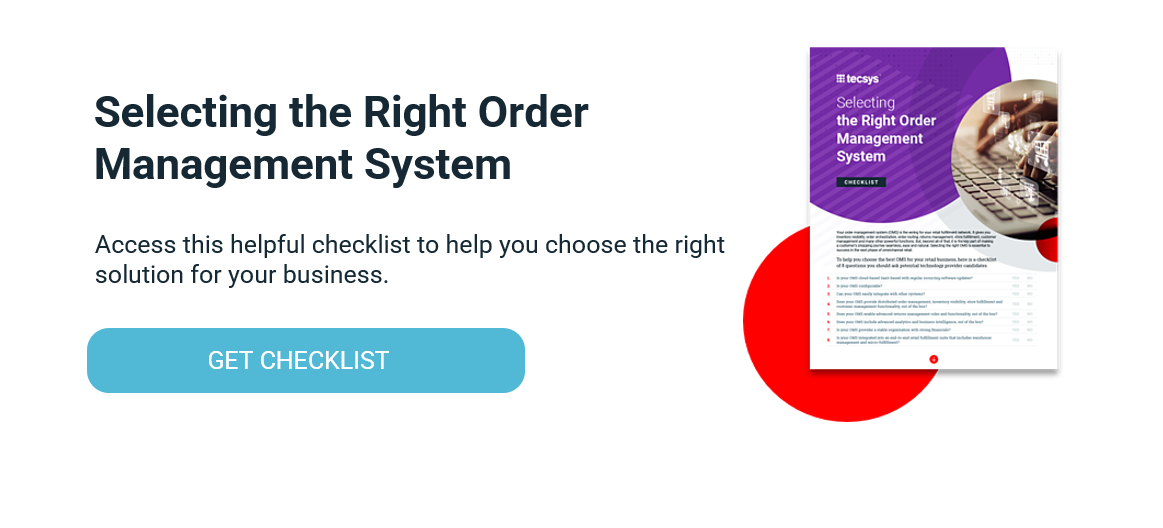Five Types of Order Management Systems

If you purchased your order management system (OMS) five or ten years ago, you probably felt like you were on the leading edge of fulfillment technology. But back then there were not many types of order management systems to select from either. Since that’s not the case anymore, you might be feeling like your old and glitchy on-premise OMS isn’t cutting it in today’s omnichannel world … and you’re probably not wrong for feeling that way.
Today, e-commerce can take up to a quarter or more of a retailer’s total revenue and that number is growing. To successfully manage this growing business segment, your OMS must have complete integration between your distribution centers (DCs), stores, drop-shippers, 3PLs, e-commerce platform (ECP), enterprise resource planning system (ERP), warehouse management system (WMS), point of sale system (POS), marketplaces … did I miss anything? Oh yes, your OMS must be able to reconcile the digital with the physical in real time, enable multiple delivery methods and manage returns to meet evolving customer expectations. Whew!
Therefore, if your OMS is beginning to feel like your old iPod or flip phone then you probably should start doing your research on the different types of order management systems on the market that will help you optimize your omnichannel offering. There is a myriad of options available to you, from basic systems that give OMS a bad name to enterprise systems that require an army of IT folks to manage. So how do you decide what type of order management system is right for your business?
Start With Your Customer
It’s no secret that customers are now more demanding than ever before. And in today’s omnichannel world, fulfillment is everything. Getting the right item from point A to point B when the customer expects it and at a cost that doesn’t eat the margin up. Sounds simple, right? It’s not. It’s insanely complicated. And that’s why you need to find an OMS that is responsive, agile and can deliver on your promises to customers.
The thing is, not all OMSs are created equal. To help you figure out what OMS is right for your business, let’s examine some typical types of order management systems available on the market today.
Types of Order Management Systems
1. The Supply Chain OMS (Retail Fulfillment Suite)
The retail fulfillment suite is a set of fully integrated solutions that can be implemented standalone or combined, depending on a retailer’s needs. Whether you’re a specialty or big-box retailer, a wholesale brand with stores or a DTC, you need an integrated suite of solutions which includes an OMS, e-commerce warehouse management system (WMS), transportation management system (TMS) and micro-fulfillment center (MFC) capabilities. These connected systems will enable you to not only respond to unique fulfillment challenges, but help you manage and optimize the omnichannel experience from click to customer. The battle for retail supremacy is fought in the supply chain and you need a supply chain OMS to help win that battle.
2. The Bundled OMS
There’s a saying that goes “don’t put all your eggs in one basket” and with a bundled OMS system, that’s exactly what you’re doing. This type of OMS is offered as an additional module of an ECP, ERP or POS. As with anything that’s bundled, you’re not getting an optimal OMS solution. It’s designed for the vendor to entice you into thinking you’re getting more for your buck. Key selling points could be quick integration, single billing and one-stop shop. However, out-of-the-box integrations/connectors and REST APIs have become standard issue, so the argument for quick integration loses steam quickly. In reality, this solution is not as robust as a true OMS and the functionality typically falls short of expectations.
3. The Enterprise Solution
Traditionally, this is the big, bloated system which requires a big, bloated IT team to run the technology. It’s possible you might have one of those original on-prem enterprise OMS running right now and the vendor might even be trying to get you to switch to its SaaS offering. Before “upgrading” and making a decision you might regret, you need to do a proper needs analysis. Is this vendor giving you what you really need (i.e., solving your complexity problems, addressing your needs in their product roadmap, etc.) or are there alternatives that can provide better time to value and ROI based on your requirements?
4. Start-up Best-of-Breed
This type of OMS is all about order management … but that’s it. Which means the OMS is missing a key piece of the functionality you need in today’s omnichannel world — fulfillment. Fulfillment is everything, remember? Not to mention a best-of-breed OMS tends to be VC-backed SaaS or private companies, where if the funding runs out, your system goes dark. You might want to consider having a peak at their balance sheet before committing to a contract.
5. Build Your Own System
And finally, there is the OMS that is built by your IT team or third-party developer. The trouble with this type of OMS — beyond the upfront investment and continual maintenance costs — is that the system is create based on current supply chain processes and models. While other retail systems (i.e., retail planning software) can run for years with essentially the same logic, order management is different because it evolves constantly. It must continually be refined. What happens when your fulfillment becomes more complex? It’s back to development in order to add additional functionality to solve additional complexity. Whereas with a configurable OMS, you can simply turn on that functionality when you need it.
Your OMS Must Support Your Customers
Shoppers have gotten a taste of what’s possible, whether it’s inventory visibility, click and collect, home delivery, cross-channel returns, etc. They expect it from every store they shop at. They don’t care that you can’t do same-day delivery because your DC is in another county. They don’t care that you can’t get it ready in two hours at the store of their choice because you don’t have the required systems/processes/people in place. All they care is that they want their order when they want their order. If you can’t deliver that to them, they’ll find a retailer who can.
With the up and down nature of shopper sentiment, retailers need to be able to respond to shoppers’ evolving needs. Omnichannel is not going away. It’s only going to get bigger. Now’s the time to put that legacy OMS in the bottom drawer. Select the type of OMS that supports retail fulfillment and is designed for the future.




